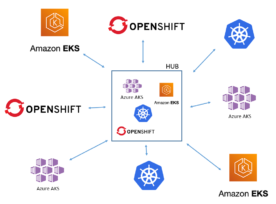Introduction Whether you have already adopted Openshift or are considering it, this article will help you increase your ROI and productivity by listing the 12 essential features including with any Openshift subscription. This is where Openshift shines as a platform when compared to pure Kubernetes engine distributions like EKS, AKS, etc. which are more barebones […]
Matthieu Rethers
Matthieu Rethers is a senior solution architect with the Cloud Platform Solutions team at Perficient with 20+ years experience in application development and cloud architecture. Matthieu is also an Openshift and AWS Certified Professional. The CPS unit helps organizations modernize and accelerate software delivery through Kubernetes and cloud adoption.
Blogs from this Author
6 Steps to successful autoscaling on Kubernetes
Introduction One of the big drivers of adopting containers to deploy microservices is the elasticity provided by platforms like Kubernetes. The ability to quickly scale applications up and down according to current demand can cut your spending by more than half, and add a few 9s to your SLAs. Because it’s so easy to setup […]
Kubernetes Multi-Cluster Management – Part 3
Introduction In part I of our Kubernetes multi-cluster management series, we’ve talked about the basics of GitOps and explained why you should really consider GitOps as a central tenet of your Kubernetes management strategy. In part II, we looked at a reference implementation of GitOps using ArgoCD, and how to organize your GitOps repositories for […]
Announcing AWS ROSA Accelerator “Devops-In-A-Box”
Today we’re making our Openshift on AWS (ROSA) accelerator available for everybody to use *free of charge. This solution is the product of years of experience on the ground delivering application modernization on containers to some of the biggest companies in the world. With the release of ROSA (Red Hat OpenShift on AWS) at the […]
Kubernetes Multi-Cluster Management – Part 2
Introduction In Part I of our multi-cluster management series, we’ve introduced GitOps and gone over some of the reasons why you should adopt GitOps for the management of Kubernetes clusters. GitOps is always the #1 thing we set up when starting an engagement and we’ve spent a lot of time perfecting our best practices. Today […]
Review of Industrial IoT Solutions – Part I
Introduction Edge computing and more generally the rise of Industry 4.0 delivers tremendous value for your business. Having the right data strategy is critical to get access to the right information at the right time and place. Processing data on-site allows you to react to events near real-time and propagating that data to every part […]
Kubernetes Multi-cluster Management – Part 1
Introduction With more and more organizations adopting Kubernetes across multiple teams, the need for IT to provide a way for these teams to quickly provision and configure clusters is increasing fast. This is not only true in cloud environments but also at the edge, and from a practical standpoint, adding more clusters can become exponentially […]
Introducing Our Container-Native Modernization Suite for ROSA
As a launch partner for Red Hat OpenShift Service on AWS (ROSA), we’ve developed a DevOps-in-a-box reference architecture and Kubernetes-based implementation for rapid application modernization. Kubernetes is an open-source container orchestration platform that automates many of the manual processes involved in deploying, managing, and scaling containerized applications. This means you can cluster together groups of […]
An Inside Look at Managed Clusters
Spend a few minutes with one of our Red Hat technical experts, Matthieu Rethers, as he discusses the advantages and disadvantages of managed clusters, as well as differences between them on various cloud platforms, when you should use them, alternatives to managed clusters, and how Red Hat OpenShift fits into the picture. When should developers […]
Keep Your Fish Warm: Event-Driven Architecture on OpenShift
Typically, the idea of container orchestration is associated with DevOps, and while IT departments have quickly adopted the tech for OPS, the development part has been misunderstood and underrated. With the array of OpenShift tools at a developers’ disposal, it’s time to deliver on the premise of DevOps and bring power back to the developers. […]









